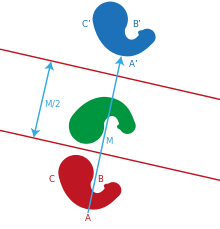Translation (geometry)


In Euclidean geometry, a translation is a geometric transformation that moves every point of a figure or a space by the same amount in a given direction.
In Euclidean geometry a transformation is a one-to-one correspondence between two sets of points or a mapping from one plane to another.[1] A translation can be described as a rigid motion: the other rigid motions are rotations, reflections and glide reflections.
A translation can also be interpreted as the addition of a constant vector to every point, or as shifting the origin of the coordinate system.
A translation operator is an operator such that
If v is a fixed vector, then the translation Tv will work as Tv: (p) = p + v.
If T is a translation, then the image of a subset A under the function T is the translate of A by T. The translate of A by Tv is often written A + v.
In a Euclidean space, any translation is an isometry. The set of all translations forms the translation group T, which is isomorphic to the space itself, and a normal subgroup of Euclidean group E(n ). The quotient group of E(n ) by T is isomorphic to the orthogonal group O(n ):
- E(n ) / T ≅ O(n ).
Matrix representation
A translation is an affine transformation with no fixed points. Matrix multiplications always have the origin as a fixed point. Nevertheless, there is a common workaround using homogeneous coordinates to represent a translation of a vector space with matrix multiplication: Write the 3-dimensional vector w = (wx, wy, wz) using 4 homogeneous coordinates as w = (wx, wy, wz, 1).[2]
To translate an object by a vector v, each homogeneous vector p (written in homogeneous coordinates) can be multiplied by this translation matrix:
As shown below, the multiplication will give the expected result:
The inverse of a translation matrix can be obtained by reversing the direction of the vector:
Similarly, the product of translation matrices is given by adding the vectors:
Because addition of vectors is commutative, multiplication of translation matrices is therefore also commutative (unlike multiplication of arbitrary matrices).
Translations in physics
In physics, translation (Translational motion) is movement that changes the position of an object, as opposed to rotation. For example, according to Whittaker:[3]
If a body is moved from one position to another, and if the lines joining the initial and final points of each of the points of the body are a set of parallel straight lines of length ℓ, so that the orientation of the body in space is unaltered, the displacement is called a translation parallel to the direction of the lines, through a distance ℓ.— E. T. Whittaker: A Treatise on the Analytical Dynamics of Particles and Rigid Bodies, p. 1
A translation is the operation changing the positions of all points (x, y, z) of an object according to the formula
where is the same vector for each point of the object. The translation vector common to all points of the object describes a particular type of displacement of the object, usually called a linear displacement to distinguish it from displacements involving rotation, called angular displacements.
When considering spacetime, a change of time coordinate is considered to be a translation. For example, the Galilean group and the Poincaré group include translations with respect to time.
See also
- Advection
- Rotation matrix
- Scaling (geometry)
- Transformation matrix
- Translation of axes
- Translational symmetry
- Vertical translation
External links
| Wikimedia Commons has media related to Translation (geometry). |
- Translation Transform at cut-the-knot
- Geometric Translation (Interactive Animation) at Math Is Fun
- Understanding 2D Translation and Understanding 3D Translation by Roger Germundsson, The Wolfram Demonstrations Project.
References
- ↑ Osgood, William F. & Graustein, William C. (1921). Plane and solid analytic geometry. The Macmillan Company. p. 330.
- ↑ Richard Paul, 1981, Robot manipulators: mathematics, programming, and control : the computer control of robot manipulators, MIT Press, Cambridge, MA
- ↑ Edmund Taylor Whittaker (1988). A Treatise on the Analytical Dynamics of Particles and Rigid Bodies (Reprint of fourth edition of 1936 with foreword by William McCrea ed.). Cambridge University Press. p. 1. ISBN 0-521-35883-3.